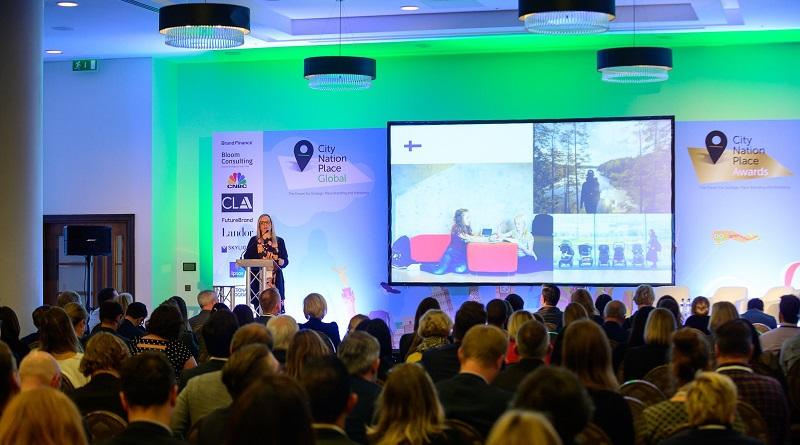Dr Natasha Grand of INSTID, the Institute for Identity, attended the City Nation Place Global Forum in London last week as a “special observer” for TPBO. Here she shares her thoughts on the event, together with a few key takeaways.
The City Nation Place forum celebrated its 5th anniversary last week in London, with fresh sky-blue graphics, a playful world map and an expanded list of sponsors. The audience were purposeful consultants and enthusiastic practitioners, with good attendance spread around the globe, especially from Europe, and the Americas.
There were plenary sessions and breakout workshops. Phones went up synchronically to capture slides containing conceptual words and graphs. The topics were the familiar mix of case studies, and management (a good plenary on finance), communication, and assessment issues.
The keynote belonged to Simon Anholt, who, in spite of professed self-exclusion, maintains a deity-like status with place branding practitioners.
Over the years, Simon’s tone has evolved from angry and urging to calm and measured, but his message stayed the same: the field apparently is going in circles, chasing its own tail, and the exercise of ‘branding’ i.e. reputation management is allegedly a waste of taxpayer’s money because no advertising effort can beat deeply ingrained national stereotypes. “Don’t try to look good, do good instead, and interest and money will follow”, was the gist of Anholt’s sermon.
Yet, comparing the content of CNP’s talks over the years, the field has moved, at least in two ways:
Personalisation
Human contact matters much more for place branding professionals now than some 10 years ago. Stakeholder engagement has become common practice (although still arguably often done wrong and missing the point in most cases).
Communication experts (PR officials for Grenada and Rotterdam, Rob Bates and Kim Heinen) advise working with individual freelancers rather than media staff writers.
Data gurus claim data has become “vast and rich” as regards people’s preferences (Jason McGrath, Ipsos). Crowds have become faces, and practitioners and consultants are more willing to acknowledge and engage ‘the public’.
Experience
The realisation that ‘doing’ is more important that ‘being’ has already sunk in. To illustrate, the head of Billund marketing, Kristine Schmidt, emphasised pointedly: “All our effort is not about attracting tourism or investors; we are seriously focused on making the town the best possible place for children as we profess; that’s the primary goal.”
Finland, who never seem to put their foot wrong in their place branding work, have shown fresh instalments of their hands-on brand experience exercises.
Why Anholt is both right and wrong
So, is Simon Anholt right when he says that all you need is to show leadership in a particular field, and money and glory will come naturally?
Yes and No. One may agree with Anholt that national stereotypes are deeply ingrained and that they evolve through action and deeds rather than advertising clips. Yet, only very precious few countries, let alone regions or cities, have the luxury of having a particular stereotype, or ticking a particular box in a global mental map. Most places are unknown, strange, weird and potentially dangerous.
What’s worse, they are uncertain about themselves. Stakeholder interviews in such places produce self-portraits that are hardly ever more detailed than ‘interesting, good, diverse, and welcoming’.
So, if you don’t know yourself, how can you choose where and how you can contribute to the world’s welfare?
My qualification on Anholt’s axiom is that before a place can take leadership in anything, they need to have the essential confidence and agreement among the locals that:
a) they are capable of contributing on the world stage, and
b) they know what they are good at and where they can make a difference.
This is – dare I say – a question of identity.
The way ahead for place branding
So where can place branding move from now? Is there room for it to grow and develop as a discipline?
I think the experience theme is here to stay and will become more salient. Not in terms of more diverse tourist propositions, but in terms of defining and communicating the way of life of a place and inviting outsiders to join.
The focus is shifting from outward selling, to inward confidence-building and lifestyle creation. Place branding not for visitors, but for the locals. Place branding as a way of finding consensus, or the only currently available civic, organic, and non-political way of deciding who we are, how we live here together in this place, and what we can do for the others.
CNP will live to see its 10th anniversary, and Simon Anholt may be pleased to change his conference appearance to a more complimentary and celebratory one.
More about Natasha Grand’s work in her interview, her speaker profile or the company profile of INSTID.
Missed the conference? You can still see all the presentations by becoming a digital delegate. Keen to find out about some of the best practice examples in place branding? CITY NATION PLACE AWARDS winners here. Place Brand of the Year: essential Costa Rica.


